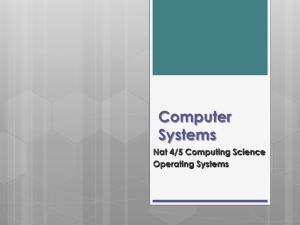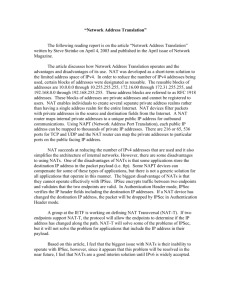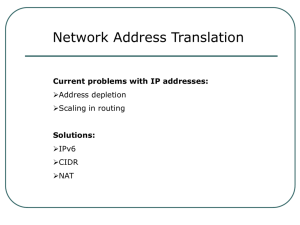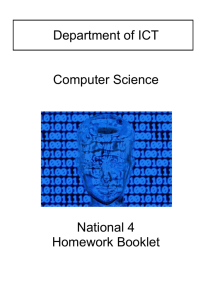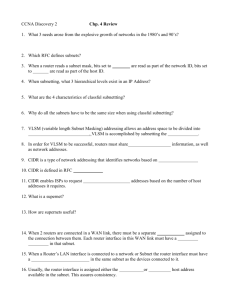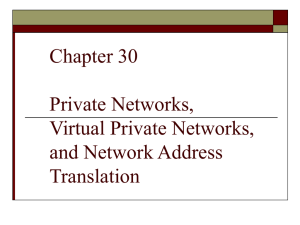Lecture 21
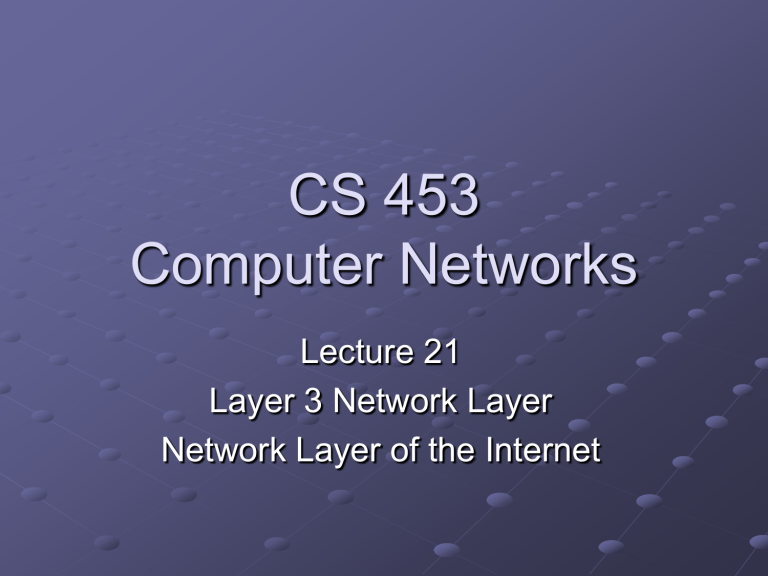
CS 453
Computer Networks
Lecture 21
Layer 3 Network Layer
Network Layer of the Internet
IP Network Address Translation
NAT
NAT
Remember that IP addresses should be unique – Globally, Universally
There are not really enough IP addresses to go around
Many situations where you have a single
“legitimate” IP address
So, how do you expand your local area network with that single address
Network Address Translation - NAT
IP Network Address Translation
NAT
Common scenario —
NAT
You buy a cheap ethernet switch/router from Nerd-R-
Us to install at home
Your connect it to your Cable modem
Your router acts like a single DHCP client – gets a single IP address from the ISP
So, you hook up your mother-inlaw’s computer,
Uncle Fred’s computer, and you throw a Cat5 cable out the window to your neighbor and connect his computer to your router
Ok, but…
IP Network Address Translation
NAT
NAT
Common scenario —
… you can’t all use the same ISP assigned IP address…
How would packets know which host they are going to, coming from
Network Address Translation
IP Network Address Translation
NAT
NAT
There are three special IP address ranges
Non-routable
Non-unique
These are
10.x.x.x
192.168.x.x
???
So the “backside” of the router issues DHCP addresses too,…
…but these addresses are from the non-routable families
IP Network Address Translation
NAT
NAT
Recall that the IP packet header contains the
IP address of the host, .
… but also the socket that the transport layer is using
From the outside all hosts in our little LAN look like they have the same IP address
IP Network Address Translation
NAT
NAT
The router creates a table…
The router assigns each internal host a port number, along with the
The table maps the external IP+port to the internal IP in the local LAN
External IP/Port
157.182.99.99/5050
157.182.99.99/5051
….
Internal IP
10.0.0.15
10.0.0.16
….
IP Network Address Translation
NAT
NAT
From: Tanenbaum, 2003, 446
IP Network Address Translation
NAT
NAT
NAT really irks a lot in the IP community
Violates the IP unique address rule
IP is connectionless, NAT creates a connection
Must track state
Violates protocol layer convention
Dips into IP header (port address)
Breaks on some protocols (payload imbedded addresses
Might not be able to scale to large subnet
ICMP
Internet Control Message Protocol
In addition to all the user, host to host message traffic using IP protocol in the network…
Routers, switches and other devices need to talk to each other
…to keep the network running
They have their own protocol for doing this
ICMP
Message
Destination Unreachable
Time Exceeded
Parameter Problem
Source quench
Redirect
Echo
Echo reply
Timestamp request
Timestamp reply
ICMP
Meaning
Packet could not be delivered
Timer/counter hit 0
Invalid header info
Source swamping network
Suggests new routing
Asks a destination to reply
Reply from echo request
Asks for a reply with a timestamp
Reply from a timestamp request
Finding Etherland
At Layer 3 we are dealing with, routing by, etc.
IP and IP addresses
But within a LAN we are using the local Layer
2/1 technology
…for example, ethernet
Within an Ethernet LAN, it sends, receives, routes ethernet frames, not IP packets
So, when a packet containing an IP address hits an ethernet LAN,…
How does it know where to go?
ARP-Address Resolution Protocol
Once on the LAN the frames address destination address must be set to the
MAC address of the destination host interface
To do this---
ARP-Address Resolution Protocol
The sending machine
Reads the IP address from the message
Transmits an ARP request – “Who does this belong to”
The IP address owner replies “Me” by returning its MAC address
The sender assigns the received MAC to the destination field in the frame header…
…and send the frame on its way
RARP
Reverse Address Resolution Protocol
What happens when you know the MAC address but you need to know the IP address?
